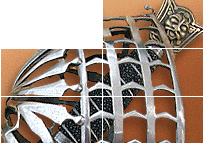| Author |
Message |
|
J. Lee
|
 Posted: Sun 05 Oct, 2008 2:42 am Post subject: A question about regimental guns after 30 years' war. Posted: Sun 05 Oct, 2008 2:42 am Post subject: A question about regimental guns after 30 years' war. |
 |
|
While Gustavus Adolvus' combination of infantry and regimental guns(increasing firepower along with
marching with the infantry) revolutionized artillery warfare of Western Europe,
I could rarely find the role of the regimental guns of later era.
(Particularly during the wars of 18th century: War of Spanish succession, Austrian succession, Sven Years' war. etc.)
Depending on limited sources, I thought that the use of regimental guns decreased as the
superior firepower provided by the regimental guns were replaced by line infantry marching in 3~4 lines deep,
all armed with flintlock muskets and bayonets.
(With the artillery's role relegated to stationary bombarding platform set apart from infantry, not marching together)
However, I am now less confident on this matter. I wonder whether I could get more clear view on this subject.
|
|
   |
 |
Elling Polden

|
 Posted: Sun 05 Oct, 2008 7:43 am Post subject: Posted: Sun 05 Oct, 2008 7:43 am Post subject: |
 |
|
The prussians used regimental guns in the 7 years war, as far as I remember. These where light and horsedrawn, and known as "galloper guns". I'm no expert though.
As a consept, the "infantry gun ", light mobile cannons, where used all the way up to WWII.
"this [fight] looks curious, almost like a game. See, they are looking around them before they fall, to find a dry spot to fall on, or they are falling on their shields. Can you see blood on their cloths and weapons? No. This must be trickery."
-Reidar Sendeman, from King Sverre's Saga, 1201
|
|
    |
 |
Daniel Staberg

|
 Posted: Sun 05 Oct, 2008 11:32 am Post subject: Posted: Sun 05 Oct, 2008 11:32 am Post subject: |
 |
|
|
Such cannon were in use until well into the Napoleonic wars. They did chage shape over time, becoming both lighter and less efficient. By the mid-18th Century they were known as battalion guns rather than as regimental cannon. The later names seems to have been mostly used by the Swedes&Germans.
|
|
  |
 |
|
J. Lee
|
 Posted: Sun 05 Oct, 2008 11:18 pm Post subject: Posted: Sun 05 Oct, 2008 11:18 pm Post subject: |
 |
|
Thank you all for answering.
| Daniel Staberg wrote: | | Such cannon were in use until well into the Napoleonic wars. They did chage shape over time, becoming both lighter and less efficient. By the mid-18th Century they were known as battalion guns rather than as regimental cannon. The later names seems to have been mostly used by the Swedes&Germans. |
Mr. Staberg, may I ask you another question if you don't mind?
Did the European armies(from late 17th c. to 18th c.) employed battalion/regimental guns as frequently
as the Swedish army of 30 years' war?
Or did the practice of moving the battalion guns along with marching infantry decrease,
and the main artillery firepower supplanted by heavier(and more static) pieces?
|
|
   |
 |
Daniel Staberg

|
 Posted: Mon 06 Oct, 2008 4:07 am Post subject: Posted: Mon 06 Oct, 2008 4:07 am Post subject: |
 |
|
I don't mind at all. Plain simple "Daniel" is fine when ever I hear "Mr Staberg" I start to look for my father :-)
Swedish use of artillery (regimental cannon & heavier cannon) in the 1630-1660 period was not equaled by other nations until the mid-18th Cenutry (War of Austrian Succesion & Seven Years War) and nor surpassed until the early 19th Century. Swedish armies of the early part of the TYW had 2.5-3 cannon for each 1000 men, in the later part of the war this grew to 3.5 to 5 cannon/1000 men. When Sweden invaded Poland in 1655 the army had 7 cannon/1000 men(!).
During the TYW the regimental cannon became heavier and thus in the end less mobile. The intial designs used by Gustav Adolf had a barrel weight of 125-140 kilos, by the 1650's the barrel weighed about 200 kilos.
In order to improve range, firepwoer and endurance the barrel had been made heavier. The increased weight amde it harder for the cannon to keep up with the infantry. Mobility was not restored until the introduction of battalion guns in the mid 18 century.
In 1645 the Swedish main army led by FM Lennart Torstensson had 63 to 81 cannon in an army that a not tiem number more that a bit over 16000 men. At the battle of Höchstädt (Blenheim) 1704 the Franco-Bavarian army had 90 cannon and 56000 men while the English-Dutch-imperial army had 66 cannon and 52000 men.
|
|
  |
 |
|
|

